Bertha's Blog
Tuesday, April 23, 2019
10 Creative Lead Gen Examples Sourced from Marketing Legends
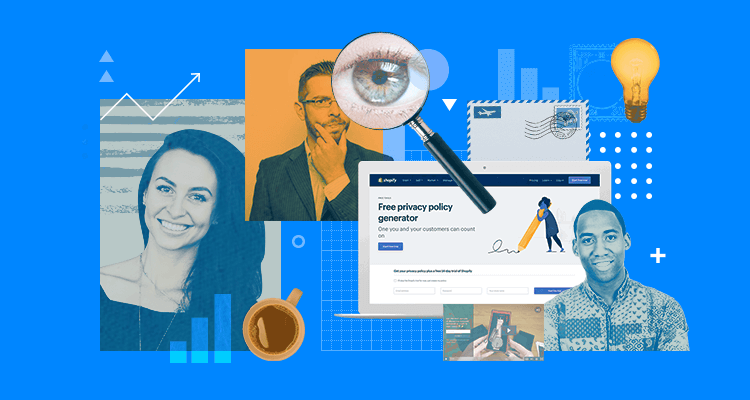
Lead generation is the number one challenge for marketers today. And it’s only going to get harder now that most Google search results pages have become saturated with promotional lead magnets masquerading as “great” content.
There are millions of free resources out there already competing for attention. And customers are quickly catching on to the fact that most of these “Ultimate Guides to Dog Grooming” aren’t really worth giving up their personal information for.
Jessica Meher, VP of Marketing at Notarize, put it really well on Twitter:
So many #SaaS companies today produce the same content mktg formulas as they did 10 years ago.
E.g. ebooks on "the complete guide to X" or blog posts on "5 reasons why." etc.
This shit works, until it doesn't. Now's a good time to invent the new ebook. Get creative.
— Jessica Meher (@jessicameher) February 6, 2018
To stand out, you need more than quality content. You need to think outside the box. Try something a little bit different. Maybe even a little bit experimental.
For inspiration, we talked to some of the most legendary marketers working today and asked them to share their most creative lead gen examples. And believe me—some of these folks needed QUITE a bit of convincing to spill their most useful and interesting ideas.
But we got ‘em here for you: 10 unique examples lifted straight from the private swipe files and secret marketing playbooks of the pros. Use these ideas as inspiration for your next lead gen campaign. Or, just keep them handy for the next time you want to try something more interesting than creating another ebook or webinar.
Ready? Let’s get cooking.
Jump to a Creative Lead Gen Example
- Create an Interactive Tool
- Embed Your Lead Gen Forms in Videos
- Interview a Third-Party Expert
- Send Attention-Grabbing Direct Mail
- Share a Customer Experience to Spark Brand Searches
- Connect via Communities
- Promote a Personalized Template
- Look for Unique Cross-Promotion Opportunities
- Start an Interesting Side Project
- Publish a Surprising Quiz
1. Create an Interactive Tool
There’s a good reason why so many brands—including HubSpot, Moz, and, yes, even Unbounce—have invested time and effort to create free tools. Tool-based marketing is popular because even simple interactive ideas can generate boatloads of qualified leads.
For example, Larry Kim, CEO of MobileMonkey, says they developed a Free Keyword Tool for the Wordstream website. Marketers could use it to research and prioritize new keywords in just a few minutes.
And while developing an interactive tool might seem like a lot more work (you might need someone who knows how to code), Larry says they were able to generate a huge number of leads as a result.
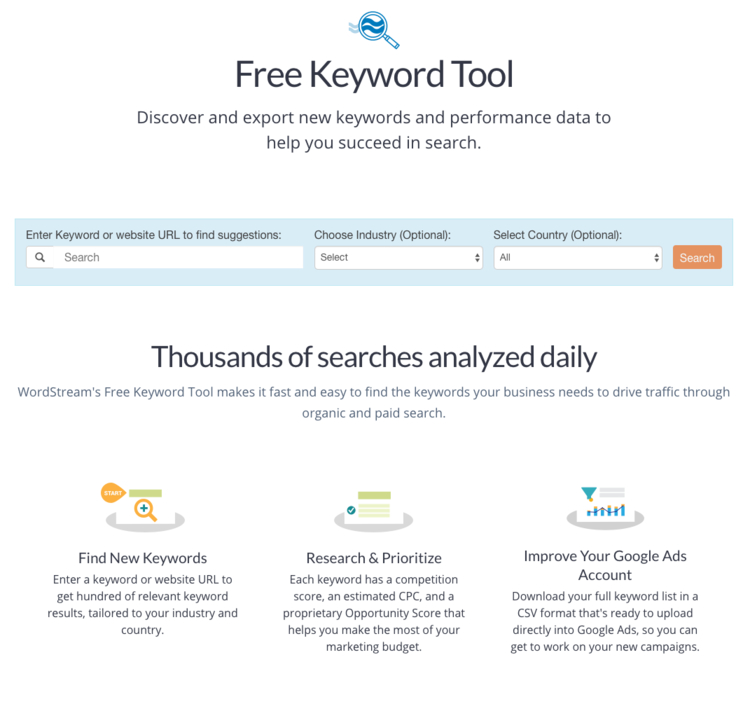
Here’s how the tool works: you start out by entering a keyword or website URL that you’re interested in analyzing. To hone the results, you can also choose the industry and country you want to focus on.
What makes this tool particularly clever is the way it displays the results. Hit the “Search” button, and you’ll instantly be able to see some of the related keywords. But all the other information? It’s hidden, blurred out, or obscured in some way.
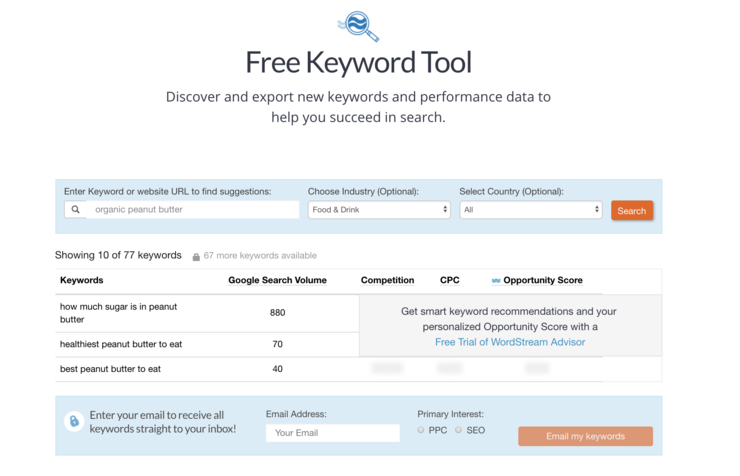
This smartly creates a curiosity gap for visitors, who feel like they’ve already started the process of doing research on their keyword. All they need to do is take one teeny-tiny extra step to get their results.
That final step? You gotta give up your email address.
Boom, lead generated.
This simple tool took just 3 months to build, yet has generated over a million email signups.
2. Embed Your Lead Gen Forms in Videos
I believe it was old Billy Shakespeare who once wrote: “To gate or not to gate? That is the question. Whether ’tis nobler in the mind to suffer the slings and arrows of outrageous website traffic, or ask for an email address against a sea of troubles…”
At some point, every marketer faces this dilemma. You have an amazing piece of content—now are you going to give it away for free as a way to attract organic traffic? Or do you gate the content and use it as a lead gen magnet?
Cara Hogan, Content Strategist for Zaius, considered these options and asked—why not both?
For their Marketing Unboxed series, Cara says they took a hybrid approach to gating each video. Rather than lock up their content entirely behind a lead gen form, they actually embedded forms into each video so they showed up as you watch.
We created the Marketing Unboxed video series as a top-of-funnel piece of content designed to engage our target audience of B2C and commerce marketers. By including a lead gen form within the video itself, we encourage people to subscribe, but we don’t require it.
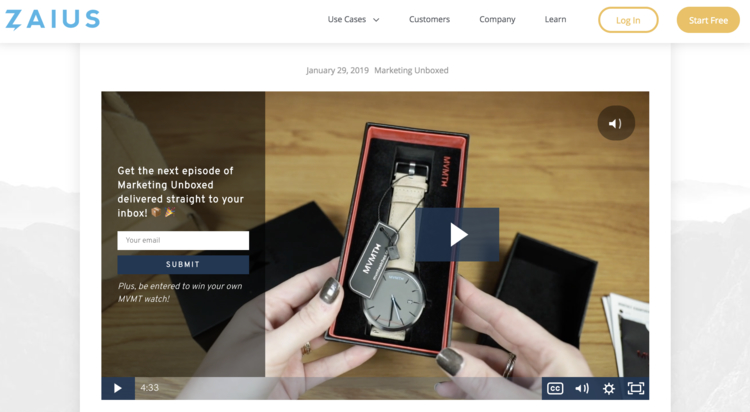
The forms draw just the right amount of your attention, without being too distracting. It slides off the video if you move your mouse off the screen, but then pops back on whenever you come back. All in all, a very classy approach that Cara says has driven some serious results.
We’ve generated hundreds of net new leads from this video series so far. We’ve only published 10 total episodes, and older episodes continue to earn subscribers over time. Some of these subscribers have since been nurtured to become new Zaius customers.
3. Interview a Third-Party Expert
For many brands, consistent blogging is one of their main sources of lead generation. Every time you put out an article, it’s an opportunity for someone new to visit your site, discover your brand, and opt in for more communications.
And there’s nothing wrong with looking outside of your own organization and team for content, either. Stepping outside of your comfort zone and providing a fresh perspective can actually be a fantastic way to bring in new audiences.
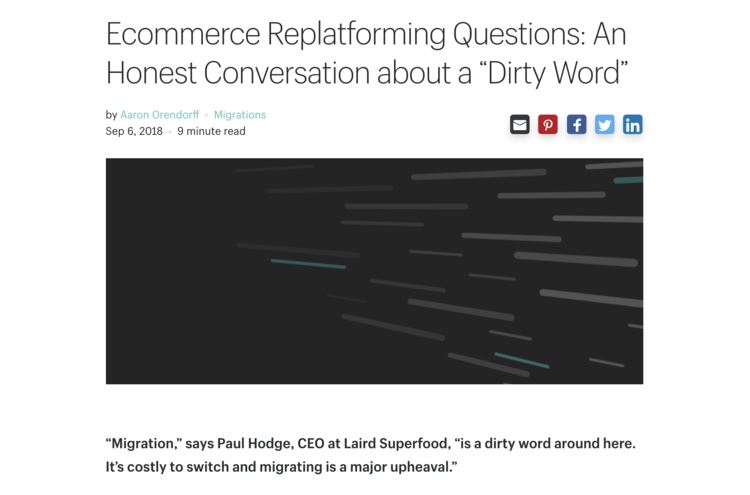
Take, for example, this lead gen example brought to us by Aaron Orendorff, Content Strategist for iconiContent. To help Shopify Plus rank for some valuable keywords, such as “ecommerce replatforming,” Aaron interviewed a high-profile expert in the industry.
Aaron says it’s the quality of the interview that makes this lead gen example work.
Rather than a heavy-handed sales pitch, the piece is an interview with Paul Rogers—one of the brightest and most respected leaders in ecommerce … That objectivity—and framing the article as an honest conversation about a ‘dirty word’—is highlighted throughout.
But wait, how do you actually generate leads with an interview or blog post? Well, Aaron explained that they peppered the article with three separate lead gen CTAs (including an Unbounce popup) to present visitors with downloadable content upgrades, related to the topic of the interview.
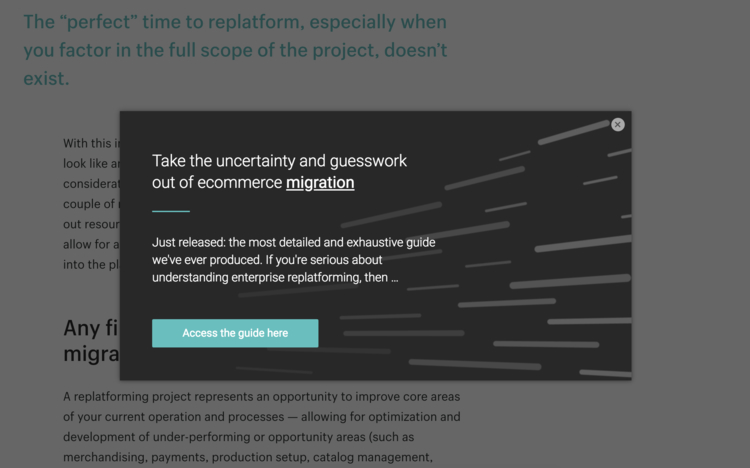
4. Send Attention-Grabbing Direct Mail
Direct mail might seem like an old school marketing tactic, but that’s exactly what makes it so darned interesting for lead generation. Why not focus your efforts on a smaller customer segment, and put together packages that really get them to sit up and take notice?
Take, for example, these direct mailers that Hero Conf sent out to promote their PPC marketing conference. The event organizers took a pretty interesting approach to get the attention of marketers like Casie Gillette, Senior Director of Digital Marketing at KoMarketing:
Oh man. @heroconf this is one of the coolest pieces of direct mail I've ever received! Who knew video could be so amazing in such a small package?
pic.twitter.com/aQnlV2y71G
— Casie Gillette (@Casieg) January 31, 2019
Each piece of mail embedded a small video screen to show clips of the presenters who would be speaking at Hero Conf. And while these must have cost a fair bit more than a typical event brochure, Casie says the unique packaging really helped to win her over.
What got me was if you played the video to the end, they had a free ticket offer—you just had to respond to the email they had sent earlier … By placing the offer at the end, only those who watched the video all the way through would learn about the offer. A really cool way to grab attention.
5. Share a Customer Experience to Spark Brand Searches
Andrew Davis, best-selling author and keynote speaker, recently pointed out that most video testimonials are pretty dry. They’re usually just a lot of talking heads, with nervous customers babbling on about all the reasons why they like some marketing brand.
But there’s also a different type of video testimonial—one that actually tells the complete customer story. And although these can be harder to produce, they can also serve up a different type of indirect lead generation for your business.
As an example, Andrew suggests watching this video on YouTube that recently went viral: Vance’s Incredible 365-day Transformation. The video currently has over 31 million views and 50,000 comments on YouTube.
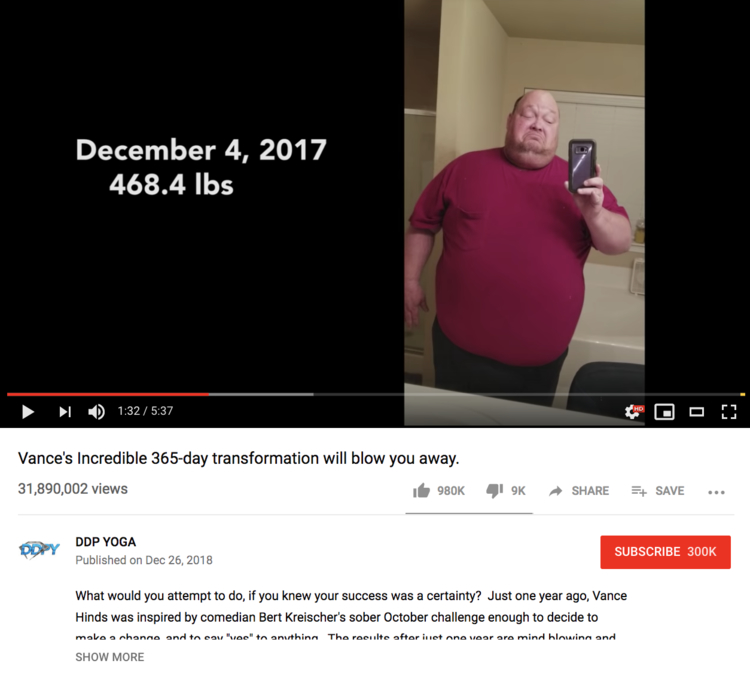
Unlike other video testimonials, this customer story is shot in real time. It’s compelling, it’s emotional—and it doesn’t have a single call to action.
Instead, Vance mentions throughout the video the diet and exercise program he is using to lose weight. The references start out subtle, but eventually become a main focus of the video. Andrew calls this an “implied CTA” that generates leads by inspiring viewers to take the next step.
A great testimonial video needs no call to action. It actually should create a moment that inspires people to do the next search … It doesn’t need a button, it just invites people who are so inspired to actually check out the next step of the product.
If you want to try this for yourself, all you need to do is start thinking about how you can frame your customer stories more like, well, stories. Connect with viewers on a personal or emotional level, and tease out the results so they get curious to learn more.
6. Connect via Communities
For freelancers, consultants, and smaller marketing agencies, you might have to take a slightly different approach to lead generation. While you can still build lists using your website and landing pages, a lot of your success will also come from word of mouth and social interactions.
For example, Nichole Elizabeth DeMeré, B2B SaaS Consultant, says their go-to lead generation strategy has been to build sincere connections with other people, in both online and offline marketing communities.
Being an active member of my favorite communities has lead to me receive leads from other members, because I’m demonstrating expertise in that domain.
Nichole says that being an active community member on websites like Growth Hackers has often lead to them becoming a part of the team, responsible for either community management or growth.
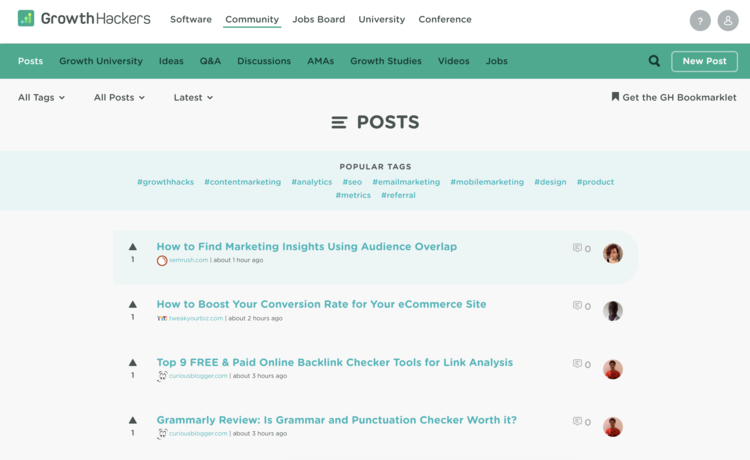
As you build relationships and demonstrate expertise, people will naturally start to think of you or your company for future opportunities. The key is to be genuinely helpful and selfless in your interactions, and to try to build actual friendships with other members of the community.
The thing is, ‘getting leads’ was never my end goal for any of these communities. I was just actively building relationships by bringing value to others.
7. Promote a Personalized Template
The right template on the right page can be a powerful tool for generating leads. That’s because visitors are willing to give up their personal information in exchange for something practical they can actually use.
But while traditional templates are usually just generic PDF downloads, Ross Simmonds, digital marketing strategist, says you can get better results by making a downloadable template that’s more personalized and interactive.
Almost every audience loves a template. If you can think about a simple template that arms your audience with the steps they need to take to solve a problem – it can be a great win. Even better; make it an interactive template that gives the user the ability to download it at the end.
As an example, Ross points towards this Free Privacy Policy Generator created by Shopify.
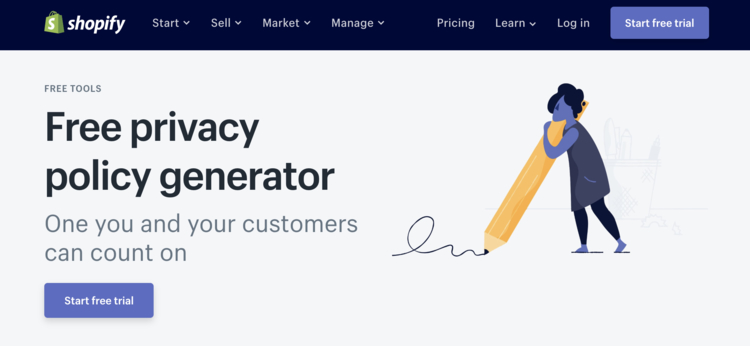
Privacy policies are one of those things that ecommerce business owners know they need, but probably don’t have time to create. And while Shopify could have given their visitors a sample policy or instructions on how to create their own, instead they decided to go above and beyond by building a personalized template generator.
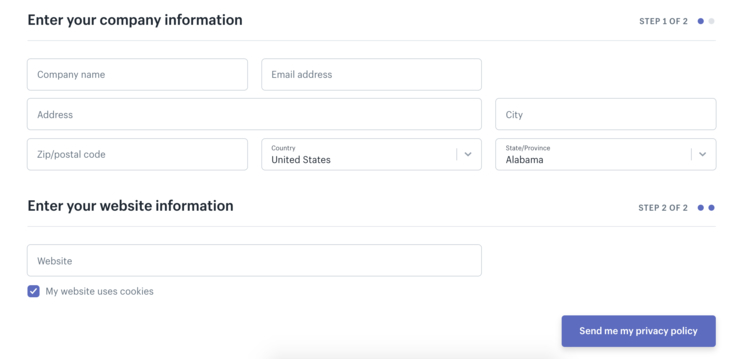
The form you fill out to generate your privacy policy serves two purposes. Not only does it help personalize the template with your company info, but it also lets Shopify follow up meaningfully with every lead that uses the tool. How cool is that?
The template approach is interesting because there’s a true value exchange. If you’re offering a template that is closely aligned with your product or service it can be both a rewarding user experience and a rewarding lead generation tactic.
8. Look for Unique Cross-Promotion Opportunities
Cross-promotion isn’t a new idea, but it’s not something too many marketers think about strategically when it comes to lead generation.
The hard part, of course, is finding the right brand to partner with. If the other company is too similar, then your audiences might already be overlapped. If the other company isn’t similar enough, then you run the risk of promoting to people who just don’t care about your brand or products.
This is where a bit of outside-the-box thinking can come in handy. Britney Muller, Senior SEO Scientist at Moz, points to this particularly clever example of cross-promotion between Hydrate IV Bar and Live Love Lash:
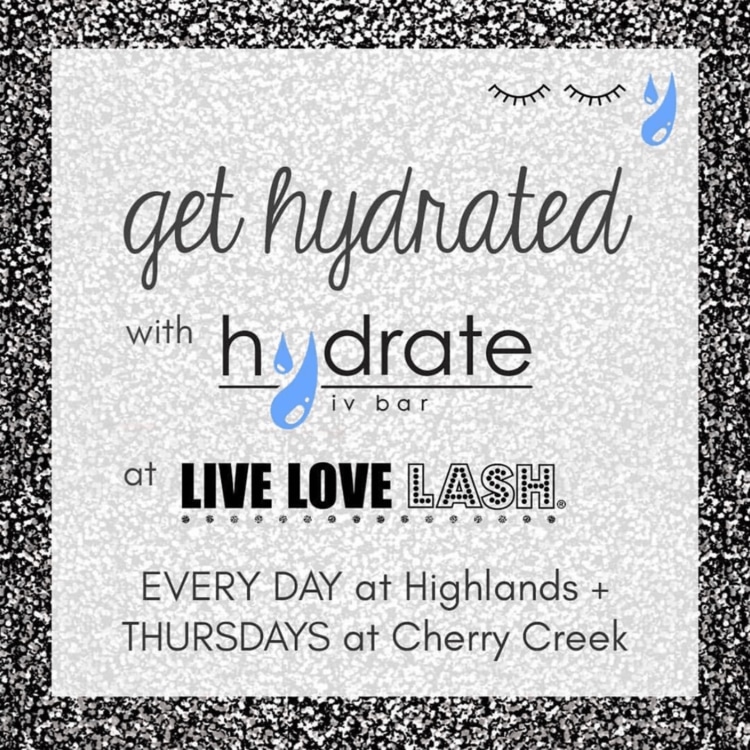
Rather than partner with another health or fitness company for their cross-promotion, the marketers at Hydrate IV Bar decided to try a different strategy. They thought about different places where their target customers might be available to try an IV bar, and struck up a smart partnership based on that:
The Hydrate IV Bar team was brilliant in thinking outside the box for local lead gen! In what instances are people in a position of stillness/rest where they could also benefit from IV therapy? Lash extensions! This cross-marketing has done very well for both businesses and feels like an efficient use of time for their customers.
And the thing is, there are all sorts of unique cross-promotion opportunities available that marketers might miss. Let’s say you’re a running shoe company, for example. The obvious cross-promotion opportunity would be a sports store, right? But you could also partner with a gym or training facility, and target athletes in the places where they spend the most time.
9. Create an Interesting Side Project
Sometimes, the best leads can come from the projects that have very little to do with your actual business. If you dig into related topics, you can discover whole segments of customers who otherwise might not have been exposed to your brand or marketing.
And when it comes to side projects, Ryan Robinson is a self-described aficionado. Once, he launched a public challenge on his blog to validate a random business idea in under 30 days with only $500.
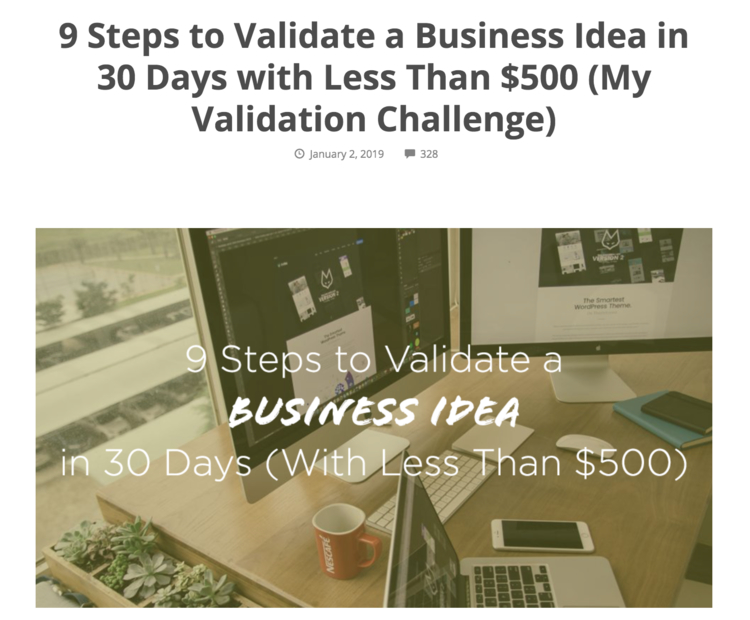
The project took up a lot of Ryan’s time for that month, even though it was something he was doing on the side. He figured it would just be an interesting way to educate readers on how to validate their business ideas, and perhaps bring in some new audiences to his blog. But he was surprised by the number of leads he was able to generate as a result.
I saw a sizable surge in traffic during my first week of the challenge. Throughout the course of the full month as I updated the challenge post, I picked up almost 3,000 new subscribers on my blog.
To take advantage of all these new leads, Ryan even built a new course based around his learning.
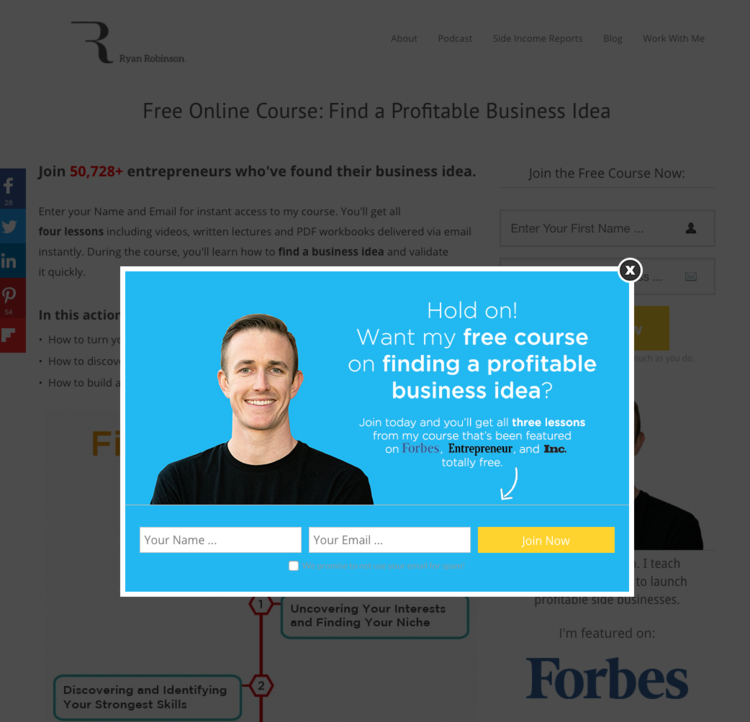
A couple months after the challenge wrapped up, I launched a course about validating ideas to that new audience … This new group of subscribers that tuned in and kept a close eye on my challenge were very qualified leads, and that course ended up generating over $15,000 in revenue during just the first week of open enrollment.
10. Publish a Surprising Quiz
Online quizzes have been around for years, but many marketers still haven’t discovered their potential for lead generation. They’re powerful because they’re so compelling—visitors actually have fun filling them out, and then get super curious about the results. (“Why yes, I do want to know which piece of IKEA furniture best represents my personality.”)
To find a creative quiz example, we went to the quizmaster herself, Chanti Zak. Chanti is a quiz funnel strategist and copywriter who specializes in creating quizzes for lead gen, and really brings a special flair to the quiz creation process.
As an example, she shared this saucy quiz she created to target entrepreneurs for Jenna Kutcher’s website.
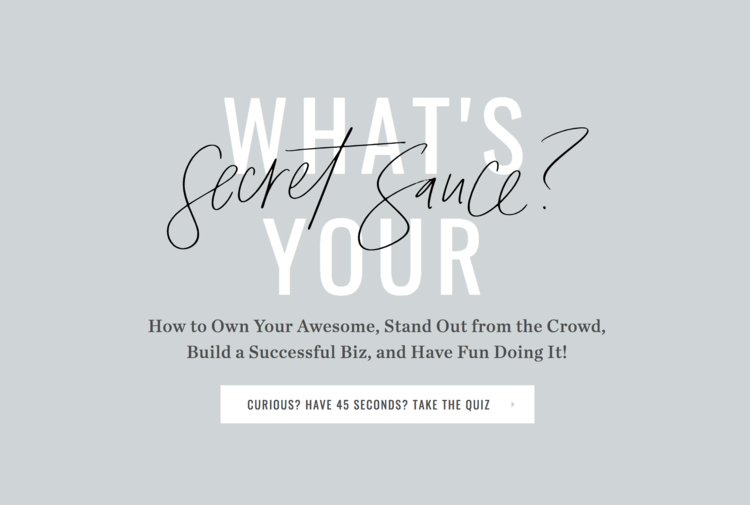
The key to a great quiz? You’ve got to surprise and delight visitors with every click, so they stay engaged throughout the process. Throw them a couple curveballs along the way, and then hit ‘em with results that speak to their unique situation.
The results go deep into what uniquely positions you to create a successful business. The custom results meet people where they’re at and are intentionally designed to empower them to take action.
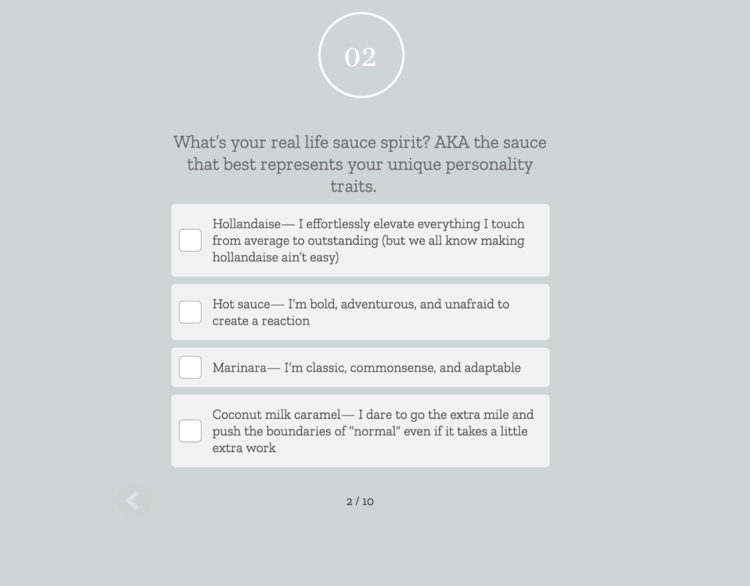
To attract the most leads, you’ll want to create a quiz that speaks directly to your brand and target market. For this example, Chanti created playful questions and answers that really get in the headspace of a budding entrepreneur.
And the strategy seems to have worked too, with this quiz alone generating over 100,000 leads.
When this interactive and personalized approach is the first impression someone has of your brand, your chances of converting them from onlooker to customer are exponentially higher than with a generic lead magnet.
Are You Ready to Take the Lead?
Of course, we’re only scratching the surface with these 10 ideas. There are all sorts of different ways to generate leads, including more tried and true methods. You could always host a webinar, offer a free ebook download, run a contest, or buy ads on social media.
Whatever you try, the most important thing to remember is that in order to generate qualified leads, you need to offer up quality content. Give those top-of-funnel leads something that’ll educate, entertain, inform, or inspire and soon you’ll be overwhelmed with too many leads. (#firstworldmarketingproblems)
Share in the comments below if you have another method of lead gen that works well for your business, or if you think there’s something we missed. The more ideas we can round up, the better!
Original Source: 10 Creative Lead Gen Examples Sourced from Marketing Legends
Monday, April 22, 2019
Friday, April 19, 2019
How to Increase Higher Education Student Engagement with Marketing
Planning your higher education marketing strategies is about working around two things: the rising cost of tuition and the growing number of students applying to post-secondary institutions. Not to mention, students have a lot of options to choose from.
To compete, you need to create digital marketing campaigns that:
- appeal to peoples’ emotions
- create a sense of urgency.
But why exactly is this the case?
Consumers attach the same personality characteristics to brands that they do to people.
Yet, this is about a lot more than creating a sense of belonging. Because your students need responsive and relevant support.
Here are some steps that you can take to improve the student experience.
Bonus resource:
Want to learn how to enroll international higher ed students? Then get our newest guide and learn about the 10 most-effective ways that’ll help you improve your enrollment campaigns in 2019.
1. Personalize your emails through making them timely
Is your newsletter not getting the results you hoped for? The issue might be a lack of personalization. It plays an important role in your students’ experience with your brand. Not to mention the fact, that it’s one of the key email marketing best practices in general, that delivers the highest results.
But what’s so important about personalization that makes it so effective?
It’s about reaching the right person with the right message at the right time.
With your students, you can do this by making them feel special…
One way you can do this is by showing your appreciation for the time and money they invested in your courses. This approach works no matter how long it has been since your students enrolled in your courses.
A great example of this is the George Brown College Continuing Education Newsletter. Since I’m one of their former students, I receive their emails on a regular basis.
A week before the holidays, they sent me a message, which showed their appreciation:

The one thing that made it effective was its timing. The email also reminded me that now is the best time to sign up for new courses if I want to enroll in the winter semester:

George Brown’s message showed up in my inbox a week before the holiday season. So, I had a head full of ideas for the new year. As a result, I asked myself “why not take another course?”
What should you do if your former students are still on your email list?
When a new semester is around the corner, remind them of your registration deadlines. But you’re likely wondering what makes former students such an asset. Cost is a major contribution; a great example of this is the emphasis colleges and universities put on international student recruitment.
To work around factors such as decreasing birth rates and shifting demographics…
The amount colleges spend on international students is increasing. Because this is happening in so many different countries, attracting international students is becoming a competitive process.
Prioritizing healthy relationships with current students and alumni will help bring down recruitment costs.
Although that seems like a lot of work, you can simplify the process. This involves setting up automation triggers, which add former students to your GetResponse Marketing Automation workflow.
Every time a student completes a course, send them an invitation to join an email list. This email list is a great way to notify students about the following:
• Registration deadlines
• And course/special event news and updates.
2. Provide incentives tempting enough to turn prospective students into current students
One of the best business models I’ve come across in the higher education sector is Brainstation.
Brainstation is a company that offers courses in the following disciplines:
- tech
- design
- digital marketing
Their students are working adults who want to upgrade their skills.
On a regular basis, they host panel discussions and events that cost as much as a cafe lunch.
So, what makes their approach so effective?
A lot of their event attendees have such a great time at their events that they register for courses. An important side note about their programs: they’re not exactly cheap. I looked up the costs, and full-time rates are $14,000 for full-time programs. Yet, they offer a scholarship program to accommodate students who can’t afford their tuition costs.
Not to mention:
- Their application process is as much work as applying for a job.
- And their courses are a huge time commitment. Students spend an average of ten to twelve months in their courses and certification programs.
So, everything I mentioned are hesitations that the organization has to work around.
The folks at Brainstation work around that by rewarding events with a high number of guests. Sometimes, they add event attendees to an email list and thank them for their time. This often involves offering a time-sensitive discount:

According to a RetailMeNot survey:
Four out of five (80 percent) consumers said they feel encouraged to make a first-time purchase with a brand that is new to them if they found an offer or discount.
Discounts will help you work around the biggest flaw of using events to attract students. They’re likely not ready to buy your courses right away. This is exactly where discounts can make a big difference.
Limited-time discounts encourage your students to stop procrastinating during the enrolment process.
But creating urgency isn’t always about charging less. Sometimes all people need to hear is a subtle reminder that they only have a limited amount of time to apply.
A great example of this is LinkedIn and how they sell their courses to LinkedIn users. This involves encouraging users to sign up for a 30-day trial of LinkedIn Learning:

This allows people to test drive the platform for free. It also allows them to decide if the monthly subscription fees are worth paying for.
There are also other ways to increase student enrollment. Here are some tips on how you can use PPC campaigns and email marketing for higher student enrollment.
3. Send emails that create accountability and fight against shiny object syndrome
One company that does this in an effective way is the Boss Project. Because their courses are online-based and aren’t time sensitive, they have to work around shiny object syndrome.
No idea what shiny object syndrome actually is? Here’s a quick definition from Entrepreneur contributor, Jayson DeMeyers:
It’s the entrepreneurial equivalent of a small child chasing after shiny objects. Once they get there and see what the object is, they lose interest and start chasing the next thing. This may be business objectives, marketing strategies, clients or even other business ventures.
Founders Abigail and Emily tackle this by sending emails that encourage student accountability. When students enroll, they receive an automated email that congratulates them on their enrolment. This email also provides a few bonus resources and instructions:

Two weeks later, students receive an email that shows them how to leave a review of the course:

So, how do you make your students feel accountable enough to:
- finish your course?
- and not switch to another course, with enticing benefits?
You need to remind them of the benefits:

An email, like the above example, will remind current students of the value of your online courses. Because it focuses on missed opportunities of not completing your courses.
The good news is that a lot of this can be automated. Once you’ve chosen the conditions and set up a workflow, your messages can be sent automatically.
Here are some examples of how you can do this with email automation.
4. Create student ambassadors who will provide honest responses to student questions
Enrolling in courses at the adult education level can be frustrating. Because answers to questions about everything from:
- course prerequisites and registration
- to learning what being a student is like, before paying tuition fees
can feel like a cold and uncertain process. A great example of that is this tweet in response to a student question:

Rather than providing a personalized answer…
They responded with a link to an FAQ page and hoped for the best.
Yet, managing social media as a higher education professional can be challenging.
The biggest challenge facing institutions is streamlining their social efforts campus-wide.
One of the many options available are student ambassador programs. Student ambassador programs include future students in a current student’s journey.
The job of the ambassadors is to use social media to capture the student experience. Because they’re students themselves, they point of view their point of view matters. But why is that the case?
Here’s an example of how an interaction with a student ambassador often “feels”:

Campaigns like these set you apart from your competition. Because they create two simple options:
- Attend the university, because it aligns with your values
- Don’t attend the university, because it doesn’t align with your values.
The feeling of campus life is especially important for international students. Because they are likely moving far away from home to enroll in your courses.
Encourage your ambassadors to produce content on everything from:
- Information on key factors such as housing, food, and the people you’ll meet
- To the experience of going to classes, writing tests, etc.
And when students have questions, encourage them to interact with ambassadors:
- in person
- over email
- and during social live stream Q&A events
Strategies like these are essential. Because social media is the first point of contact between students and universities. So, it’s important to create a first impression that counts.
But above all else…
Students are often investing a great deal of time and money. So, it’s important to focus on making transparent information accessible to:
- current students
- future students
- and alumni
Otherwise, they’ll change their mind and dedicate their time and money to something else.
Author:
 Rosemary Richings is a specialist in blog content promotion and audience outreach strategy, who offers straight up content creation for websites and blogs. Since 2014, she has worked with diverse clients in the lifestyle and ecommerce industry. The clients that she has worked with include large organizations, such as E-bay and Yellowpages Canada, and startups/ small businesses such as Lokafy and BeFunky. She has also been published on sites such as Buffer, Search Engine Journal, the Weebly Inspiration Center, and more. Check out Rosemary’s latest in her ebook, Blog on, a blogging starter kit for entrepreneurs. Feel free to connect with Rosemary on Twitter @rosiemay_r for recommended reading material, along with news about her latest projects and content.
Rosemary Richings is a specialist in blog content promotion and audience outreach strategy, who offers straight up content creation for websites and blogs. Since 2014, she has worked with diverse clients in the lifestyle and ecommerce industry. The clients that she has worked with include large organizations, such as E-bay and Yellowpages Canada, and startups/ small businesses such as Lokafy and BeFunky. She has also been published on sites such as Buffer, Search Engine Journal, the Weebly Inspiration Center, and more. Check out Rosemary’s latest in her ebook, Blog on, a blogging starter kit for entrepreneurs. Feel free to connect with Rosemary on Twitter @rosiemay_r for recommended reading material, along with news about her latest projects and content.

The post How to Increase Higher Education Student Engagement with Marketing appeared first on GetResponse Blog - Online Marketing Tips.
Thursday, April 18, 2019
Wednesday, April 17, 2019
The Sneaky Tactic Ecommerce Brands Use to Attract More Customers
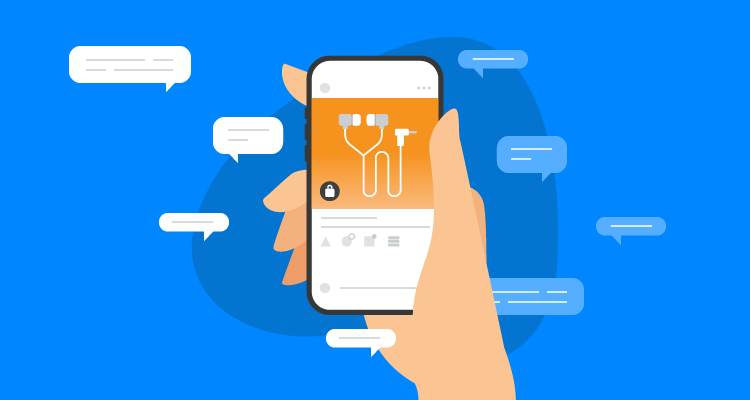
Have you ever seen that video of the kid trying to collect water in a wire bucket?
It’s pretty hilarious:

Problem is, it’s also painfully reminiscent of a lot of marketers’ strategy.
Sure, they’re working hard and hustling. But the processes, funnels, and journeys they use create more leaks than that kid’s bucket. And when each leak is losing you thousands in potential revenue, it’s something that needs your attention.
Check most funnel visualizations and you’ll see something similar to the example below: a massive loss of customers at every stage.
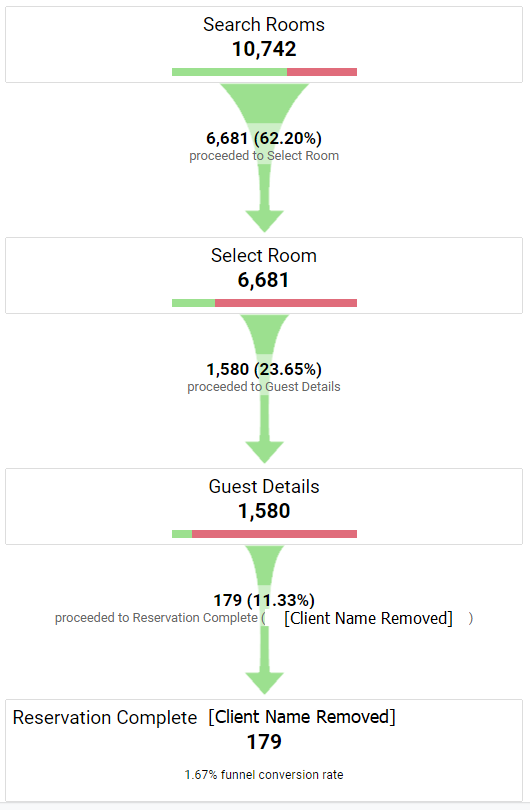
In the above example, a grand total of 1.66% of users completed a reservation.
This isn’t a standalone case either. Leaky funnels like this one are everywhere, and most marketers aren’t doing enough to fix them.
One of the major problems is that people are too aggressive with their funnels. They’re pushing the wrong product at the wrong time—to the right people.
Fortunately, there’s an easy fix, which comes down to attracting people with low threat sales before up-selling them to your main money-making products.
I’m going to run you through a sneaky little tactic that big brands—like Marvel and Ben and Jerry’s—use to drastically increase their conversion rates. And then we’re going to look at how you can leverage the success of those initial sales to fill your upsell funnel and double down on your success.
Social Commerce Streamlines the Buyer’s Journey
Social media has quickly become one of the best ways to engage and attract new customers. But you’ve got to ask yourself, why are people on Instagram, Facebook, or Twitter to begin with?
Most of the time, if we’re being honest, it’s to waste time or avoid boredom. People check out what their friends and colleagues are saying. They lose themselves watching funny videos of dogs, or maybe to get ideas for new workouts.
Very rarely do people head to social just to shop, which is why the average conversion rate is so low compared to other referral sources:
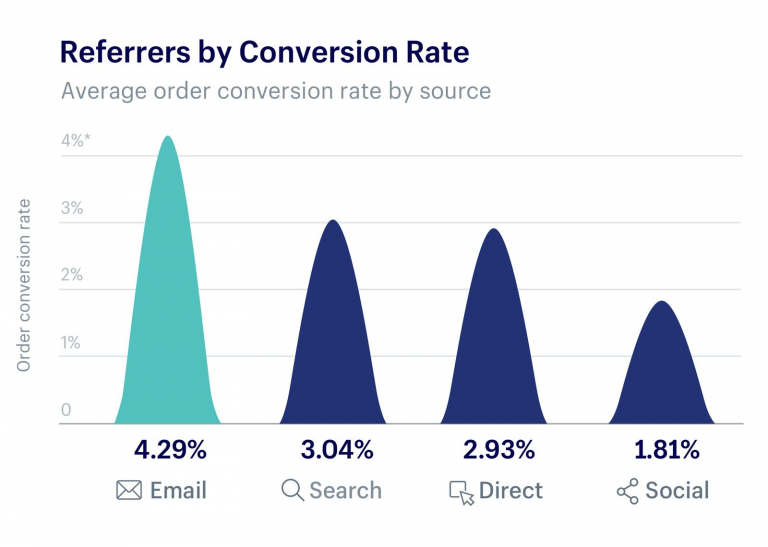
Social media users have low purchase intent. They’re looking for a distraction, not a new widget. Sure, you might pique their interest with a well-optimized social media post, but that desire wanes with every step they take:
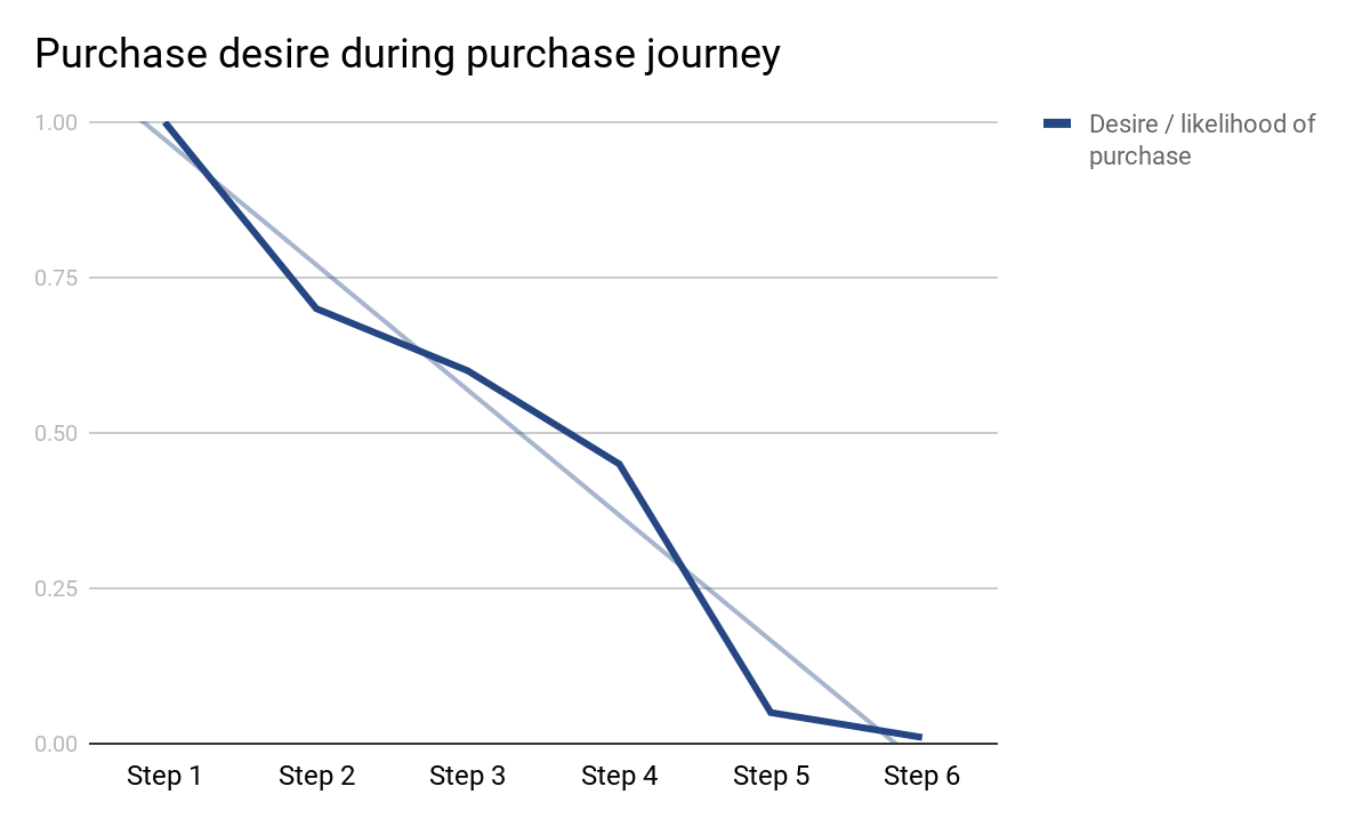
To increase conversions, you’ve got to push for the sale while purchase desire is high. And the best way to do this is to remove unnecessary steps.
How?
With a two-step checkout that takes users immediately from seeing something they want to actually buying it. This is what social commerce allows you to do.
Social commerce allows brands to sell products directly through their social media channels. It turns the posts and ads you’re already running into automated checkouts so your users can buy your products directly from their Facebook feed, your Instagram stories, or your latest tweets. A person engages with a post of a product they want, and then they’re then able to buy it through an automated chat.
Social commerce has helped brands like Marvel, who implemented the strategy when promoting Infinity War and Ant-Man and the Wasp, achieve a 58% conversion rate.
For instance, Marvel added an automated checkout bot to posts on their social channels. The posts would include something like: “comment #Ant-Man below to buy your tickets!”. And when someone commented, an automated chatbot like the one below would kick in to help users find the cinema and showtime that best fit.
Below is the actual sequence used for Ant-Man and the Wasp in Singapore:
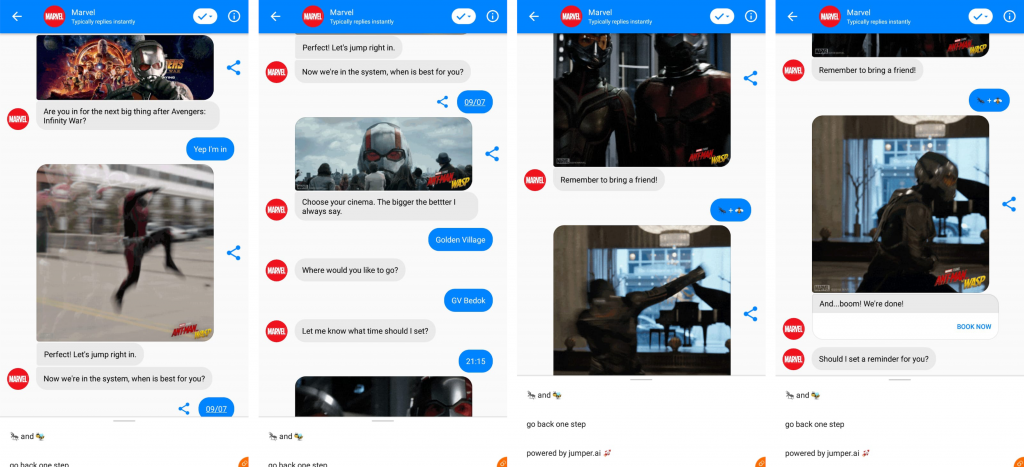
Allowing users to purchase tickets directly within the social network they were actively engaged with is a sure fire way to increase your sales and conversions.
The above Marvel campaign is proof of the concept as the simple social commerce strategy helped them achieve the below:
- It allowed Marvel to achieve a 58% conversion rate in a single campaign, rising to 68% when retargeting was taken into account.
- It also generated 18X as many comments as the next best campaign which massively increased reach.
It’s one of the best ways for brands to increase their sales. And honestly, I think it’s going to play an increasingly important role in the coming years.
But here’s the thing. It’s far from perfect…
Social Commerce Is Not a Replacement for All Marketing
The stats above make social commerce seem almost too good to be true, right?
I’m a huge proponent of social commerce. I can count more than one client over the years who operate solely in this space. But I’m not going to say it’s the perfect solution for every brand out there.
It’s the perfect solution for low-cost impulse buys like cinema tickets or ice cream. But it’s not a great solution for high ticket items.
If you’re selling $10,000 TVs, for example, then it’s not going to be a good solution for you. How many people spend that much on an impulse? How many people are scrolling through their social feeds, see a $10k item and say “go on then, I’ll treat myself.” (Very few, if any at all.)
If you check the average order value for social commerce, in fact, they all fall below $100 (most below $50):
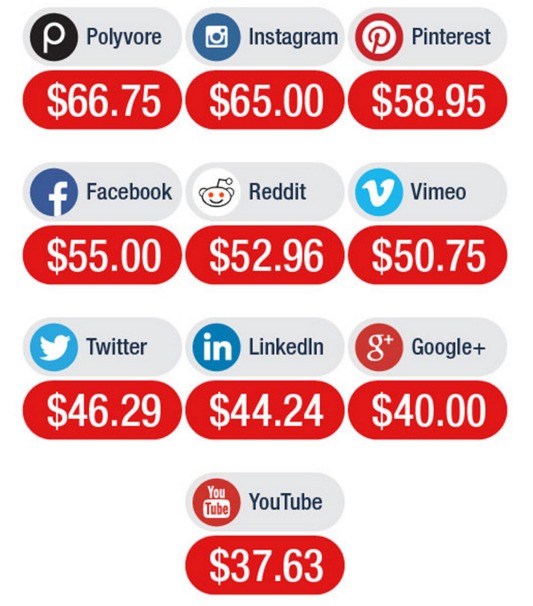
People don’t intend to shop on social, so they’re not going to spend vast amounts of cash.
Don’t despair if you are selling high ticket items, though. I’m going to run you through a couple of ideas that will help you turn the customers you attract through those low-cost impulse buys into repeat customers.
Using Social Commerce For High-Ticket Sales
To get your social commerce high-ticket funnel up and running you’re going to need a few things:
- A low price product that’s related to the high ticket item (more on this soon)
- A social commerce solution (like jumper)
- Some way to collect, store, and segment contact details (a good CRM)
- A reengagement channel (email with landing pages from Unbounce)
If you’ve got all of these then you’re ready to continue.
The long and short of this is you’re going to use social commerce to sell a low-cost product, something that would be a logical impulse buy but is still related to the main product you’re trying to sell.
You then collect the user’s details and add them into a relevant upsell funnel through your email service. And the emails point back to a personalized landing page which sells the high-ticket item most relevant to their initial purchase.
This is what it looks like:
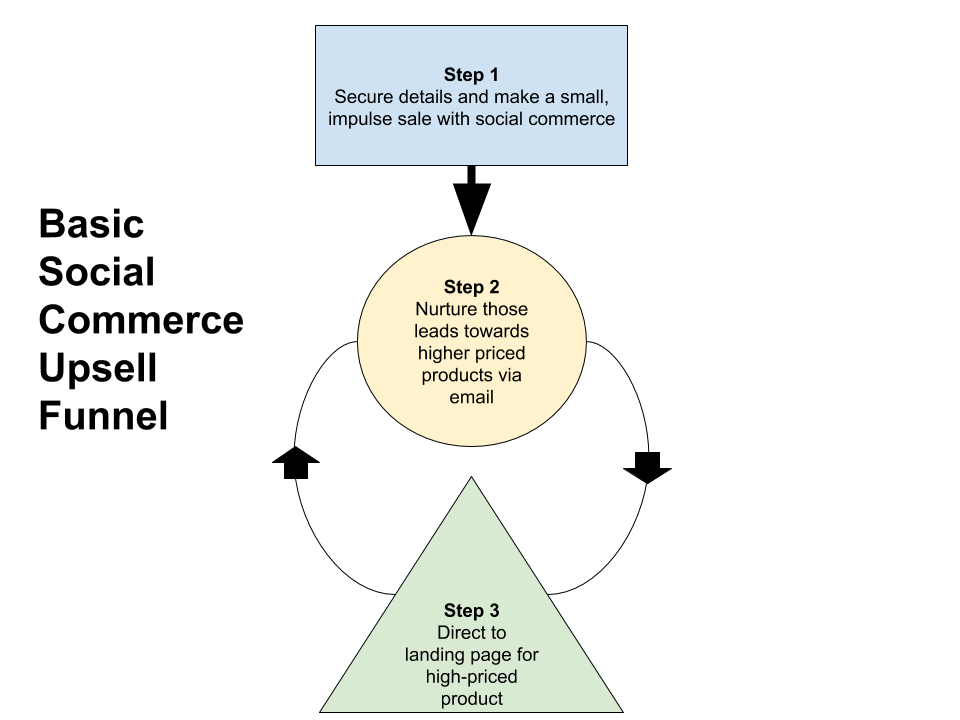
Depending on the price disparity, you can do this in one leap—or take some time to really nurture the user to get them there.
To provide an example, here’s how Ben and Jerry’s moved 5,000 free product samples in three days before upselling paid products:
They didn’t overcomplicate things and kept the whole process super simple.
But I hear what you’re saying: Moving a user from a free product to a $5-10 purchase (for ice cream, no less) isn’t difficult, nor is it representative of your brand’s products.
You’re right. It’s not. But the process is the same.
Let’s imagine you run a store targeting audiophiles and you’re trying to shift a $5,000 sound system. Your social commerce strategy could be shifting a $75 paid or in earbuds that provide superior sound. For those that purchase, you could then upsell those people on a $150 pair of noise-canceling headphones. Then a $500 set of speakers or $1,000 turntable.
With each upsell, you’re not just making more money, but qualifying the user while leading them toward the end goal.
The great thing here is that you’re never going to leave empty-handed. At the very least everyone in this funnel has paid for the $75 earbuds. If you really wanted, you could even sell them the $5,000 system piecemeal.
That’s what social commerce is great at—sorting the wheat from the chaff. You’re not just attracting “audiophiles” or whatever, but “audiophiles who will buy things from you.”
So let’s get into the details of how to set this up for yourself.
Step 1. Product Identification
Before you start looking into how to set up this funnel, you’re going to need to find the right product pairings. For the initial offer you need something that is:
- not too expensive (ideally in the ~$50 range)
- extremely relevant to the high ticket item you’re pushing
- likely to sell well on social (highly visual marketing is a must)
You’ll also need to look at the high ticket item.
A lot of people will pick a low-cost item that’s an accessory to the high ticket item. For example, for an iPhone Xs people would sell something like the case. It’s a great cross-sell, but if someone is buying the case then they already have the phone. So a couple of better options for an iPhone Xs might be:
- Cases for an iPhone 6, 7, and 8 (sell the Xs as an upgrade)
- A printer for iPhone 7 (promote the Xs on the merit of its superior camera)
You get the idea right.
These kind of items are within the acceptable price range for impulse buys. They also give you an idea of the kind of needs the user has which makes retargeting and upselling much easier. And they’re related to the end product.
Once you’ve figured out your pairings, it’s time to move onto the next step.
Step 2. Set Up Your Social Commerce Campaign
Using a social commerce solution, you can now get your campaign set up.
For instance, if you head to jumper.ai (here comes the shameless plug…) you’ll be able to sign up for a free account.
After filling in all of those business and bank details (so you can get paid!) head to the “add product” menu item on the left. Fill out your product details, pricing, variations, and other relevant information.
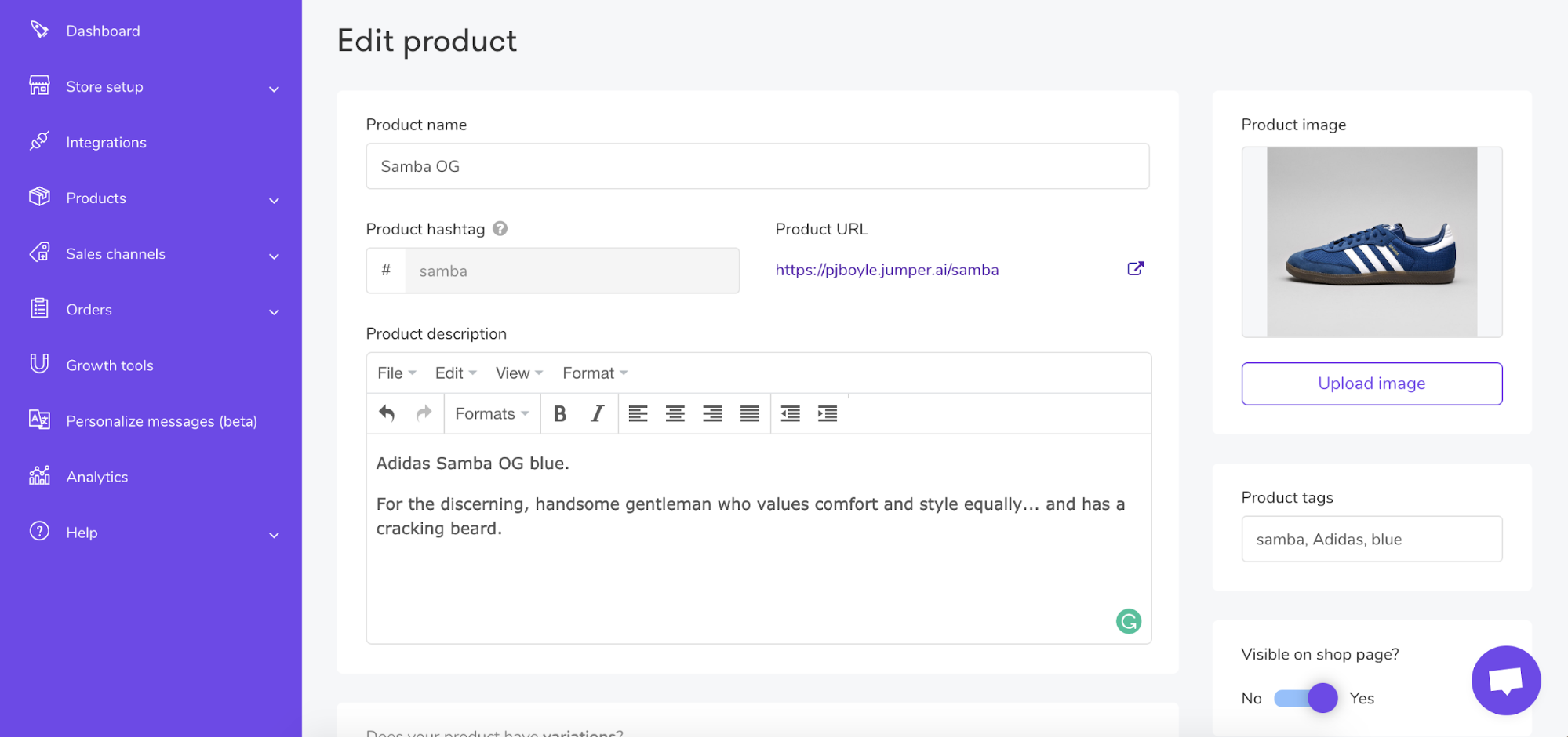
Once you’ve done that click “save” and follow the link to the “manage products” page.
Find the product you want to share and click the little tag icon. You’ll be allowed to choose the network you want to share through. Click the one you want and you’ll see a page like the one below:
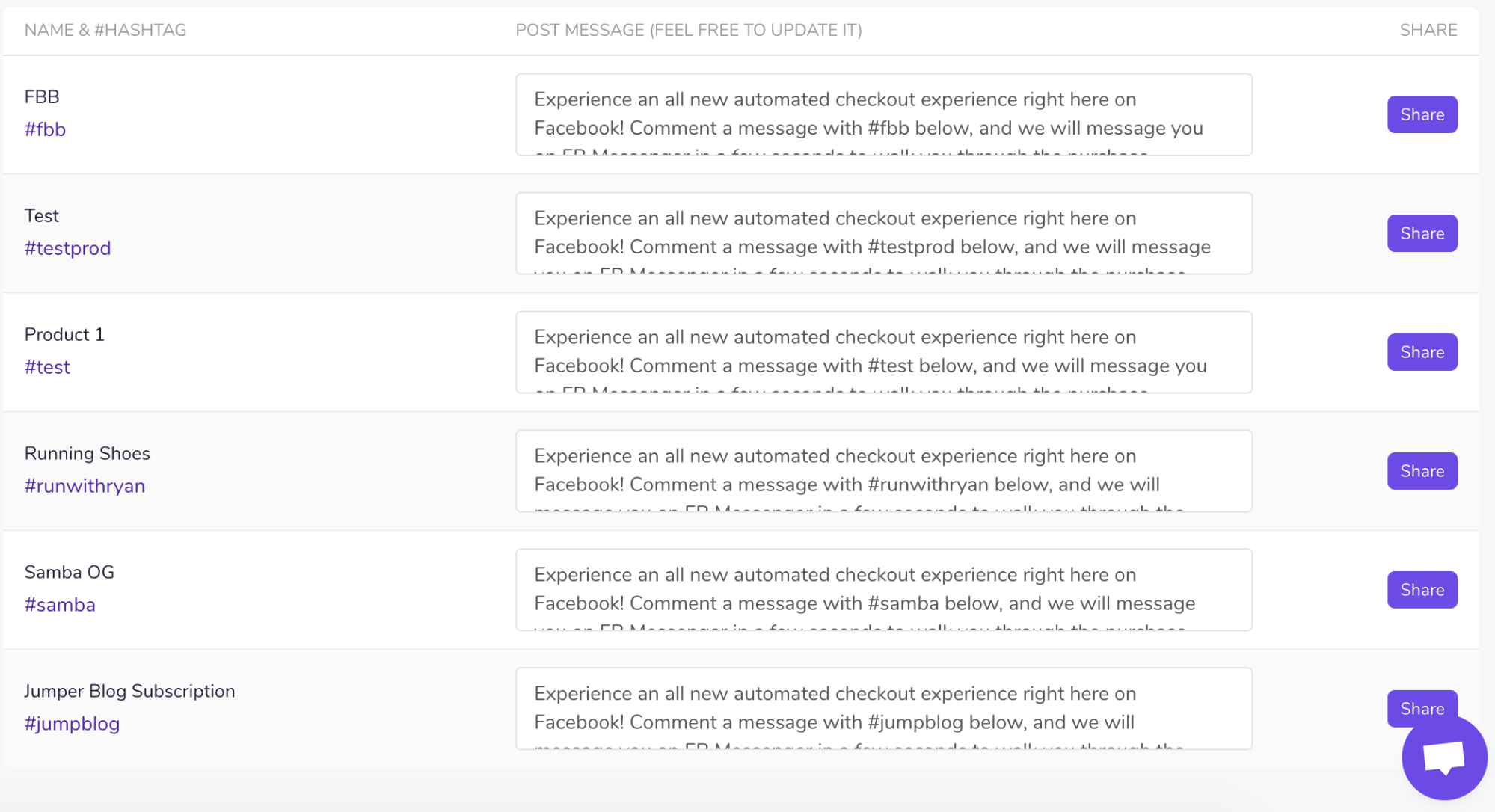
You can either go with the default text or customize it. Whatever your choice, as soon as you’re ready, hit share to send it out to that social network. Just like that, your social commerce post is live. An automated chatbot will take the user through the purchase process and collect their details and payment.
Step 3. Capture User Contact and Purchase Details
If you’re running your store on something like Shopify or WooCommerce, there are native integrations to carry the user’s information across.
If not, no worries. You can simply set up a Zap to copy the user’s details over to your ESP. I’d recommend copying over their contact details and relevant product information so you can get them into the right funnel.
Then it’s on to the fun upsell stuff.
Step 4. Email Marketing to Nurture Customers
Social commerce is great for those initial contacts and to help with the transactional stuff.
But it’s not great at nurturing relationships.
Most people engage on their mobile (with its small screen) and, thanks to the chat medium, want very short correspondence.
If you’re looking to nurture your users then email is still going to be the best method. After you’ve got the thanks out of the way you’re going to want to start increasing the user’s desire for that higher priced item.
It’s gonna take some testing your part, but I’d recommend starting by helping them get the most out of their current product purchase.
For example, if we look at the iPhone 7 printer above then I’d send emails in the below order:
- A short series on the products key features
- A short series on how to take better pics with an iPhone 7
- Intersperse some news pieces or features of the Xs throughout to put it on their radar
- Start with some sales emails that promote the Xs as the ideal solution to the pain points this segment is having
Here’s the thing with this stage: you’re not gonna get it right on your first go. You’re going to have to play around with the content of the emails and the timeline to make users feel comfortable with the price jump.
You could also try things like throwing in an incentive to push the sale:

Just remember that with email marketing value and relevance are key.
Step 5. Create Personalized Landing Pages
Once you get to those sales emails though, you’re going need to send the users somewhere.
Let’s say you’re pushing the iPhone Xs. And let’s imagine that you’ve got three buckets of users who opt-in to your lower-priced lead gen products:
- First Bucket: Shutterbugs
- Second Bucket: Audiophiles
- Third Bucket: Annoying people who boast about having the latest iPhone
You could create separate landing pages for each and every group. It wouldn’t be a bad way to go, but it’ll also take a ton of time. And the more bucket segments you have, the more difficult completing this task becomes.
This is where Unbounce’s Dynamic Text Replacement (DTR) will help out. Dynamic Text Replacement allows you to edit certain elements of a landing page to be more relevant to the prospect.
For example, switch the headline so users who come from link A see variant A and those from link B see variant B:

It’s an easy way to increase the relevancy of your landing pages.
In the iPhone example, you could create one general landing page that details the major benefits of the phone, but then switch key elements to appeal to each demographic. It cuts down on your time so you can roll out more campaigns, but it keeps the relevancy high and the messaging in line with your sales angle.
A Sneaky Bonus to Further Grow Conversions
You’ve read 2403 of my words. And that deserves praise because, well, they’re words from some guy in his home office. I like you.
So, to offer a little thanks, I’m gonna let you in on a secret. (Don’t tell anyone this I shared though. It’s only for the determined readers like you.)
The customers who work their way through this funnel were initially engaged by a social checkout. Offering the same method of checking out on the landing page should make it easier for these users to convert because:
- It’s a method they’re comfortable engaging with.
- They have experience in chat led conversions.
- The tool should remember their details so they can check out in a few clicks.
- It’s something you can easily achieve through a handy chat bubble that triggers when the user clicks the buy now button.
Overload the Top of Your Funnel with Social Commerce
Social commerce, conversational commerce, and chatbots are the three current hot topics in digital marketing. A lot of the advice out there will tell you they are the perfect solution to every problem.
But they’re not. While they will help solve a bunch of issues within your business, they’re not ideal for high ticket item sales.
The transactional, conversational solution they provide is incredible for small impulse buys. But if you want to sell something that costs a little more you’ve got to get creative. Merchants and marketers need to understand that social commerce is not a replacement for the channels you’re currently using. It’s an addition to your low-cost product sales and top of funnel strategy.
Understand that, and you’re well on the way to increasing your ecommerce store’s revenue.
Original Source: The Sneaky Tactic Ecommerce Brands Use to Attract More Customers












